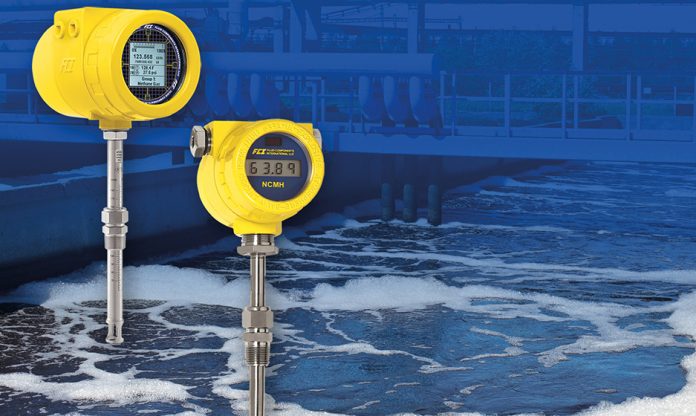Measurement In Activated Sludge Treatment
By Jim DeLee
Fluid Components International (FCI)
In wastewater treatment systems relying on the activated sludge process, diffused air is the most common method of aeration. Blowers push compressed air through a pipe distribution and diffuser system. Bubbles rise from the bottom to the top of basins, transferring oxygen to the microorganisms in the activated sludge that do the dirty work.
As a result, process air energy costs are often the largest non-labor-related expense at this type of treatment facility.
It’s therefore imperative that operators manage their air flow efficiently.
How Much Air Flow Is Needed?
Operators typically maintain dissolved oxygen (DO) levels around 2 mg/L at the end of the aeration tank. This ensures oxygen for the process without wasting electricity. But how much air flow is needed to maintain DO at the preferred level?
Engineers design systems based on the actual oxygen requirement (AOR). The AOR depends on variables including biochemical oxygen demand (BOD) and ammonia loading from influent and sidestream flows. Oxygen demand also fluctuates based on changes in temperature, flow and influent parameters.
The AOR is converted by formula to a standard oxygen requirement (SOR) based on factors including bubble size, temperature, pressure, and DO required. Another part of the aeration equation is the specific oxygen transfer efficiency (SOTE), which is dependent on the aeration device, output, diffuser depth and layout.
This information is used to calculate required air flow. Due to variable conditions, recommended air flow rates are usually noted as minimum, average, and peak values.
Inefficient Aeration Is Expensive
Optimizing aeration to control preferred DO levels not only improves plant operation, but reduces electrical costs. Blowers use more electricity than other equipment at an activated sludge treatment plant. Figures often cited are that aeration accounts for 40 to 60 percent of a plant’s energy usage.
Blower operation is specific to individual treatment plants. Some plants operate blowers based on a predetermined on/off schedule. Some run the blowers continuously at a constant rate. Most facilities run blowers continuously and adjust blower operation based on actual field measured DO readings. If the DO is too high or low, air supply is increased or reduced.
Air Flow Measurement
Most activated sludge plants have multiple blowers serving two or more aeration basins. Air is pumped through air header piping, which then branches out to each basin. Depending on the size of the plant, each basin may have multiple diffuser systems with individual drop lines feeding air to the diffusers. By monitoring air flow in the air piping system and feeding data back to a control system, air balance within the basins is optimized. This improves the treatment process and reduces energy costs.
Choosing Air Flow Meters
While several air flow sensor technologies are available, thermal dispersion flow meters such as those offered by Fluid Components International (FCI) are the most commonly specified solution. They use heat to measure air/gas flow. Two RTD sensors, one heated and one acting as a reference, are inserted into the flow stream. The mass flow rate is proportional to the differential heat dissipation between the sensors.
Easy To Install
To simplify installation, look for insertion thermal meters that require a single tap with a ball valve for insertion and removal. For systems that lack a sufficient pipe straight-run, which is common in aeration basins, flow conditioners ensure accurate, repeatable measurement.
Rugged and Low Maintenance
Wastewater treatment plants are tough environments. It is therefore important to choose flow meters that are rugged and require little to no routine maintenance and have robust, weather-proof transmitters/electronics enclosures to ensure long service lives.
FCI’s thermal mass flow meter sensors have no moving parts and no holes to foul or clog. Look for heavy-duty, metal enclosures that are rated IP65 or better. Avoid meter technologies that require extra temperature and pressure sensors to compute mass flow because they add cost and complicate installation.
Accuracy Over a Wide Range
FCI’s thermal flow meters are accurate— ±1.0 to ±2.0 percent of reading and with repeatability of ±0.5 percent. Due to variable demand at wastewater plants, meters must measure a wide range of air flow rates. Thermal meters feature wide, 100:1 turndowns covering low to these variable high flow ranges.
Look for flow meters with temperature compensation circuitry to ensure accuracy is maintained throughout the temperature range to which the transmitter and its flow element will be exposed (think cold winters and hot summers).
Reduce Costs, Improve Treatment
Rugged, low-maintenance FCI thermal mass air flow meters are operator-friendly. Their accuracy ensures optimal aeration control with minimal electricity usage. Thermal mass flow meters help wastewater treatment operators optimize treatment, enhance sustainability and reduce costs.




